MNG91220: Strategic Health Management - Critical Issue Review
VerifiedAdded on 2023/03/29
|17
|3995
|99
Report
AI Summary
This report critically reviews the strategic issue of nursing staff shortages in healthcare facilities, particularly in Australia. It uses a strategic management framework, including PESTLE analysis, to understand the political, economic, social, technological, legal, and environmental factors contributing to the problem. The report then explores change management theories, specifically Lewin's change management model (unfreezing, change, freezing), to implement strategies for staff retention. It highlights the importance of addressing issues like inadequate remuneration, lack of growth opportunities, and challenging work environments to mitigate the nursing shortage. The analysis emphasizes the need for governmental policies and organizational changes to improve the working conditions and support for nursing professionals, ultimately aiming to enhance the quality of healthcare services. The report concludes with recommendations focused on providing equal opportunities and fair compensation to address the strategic concern of staff shortages.
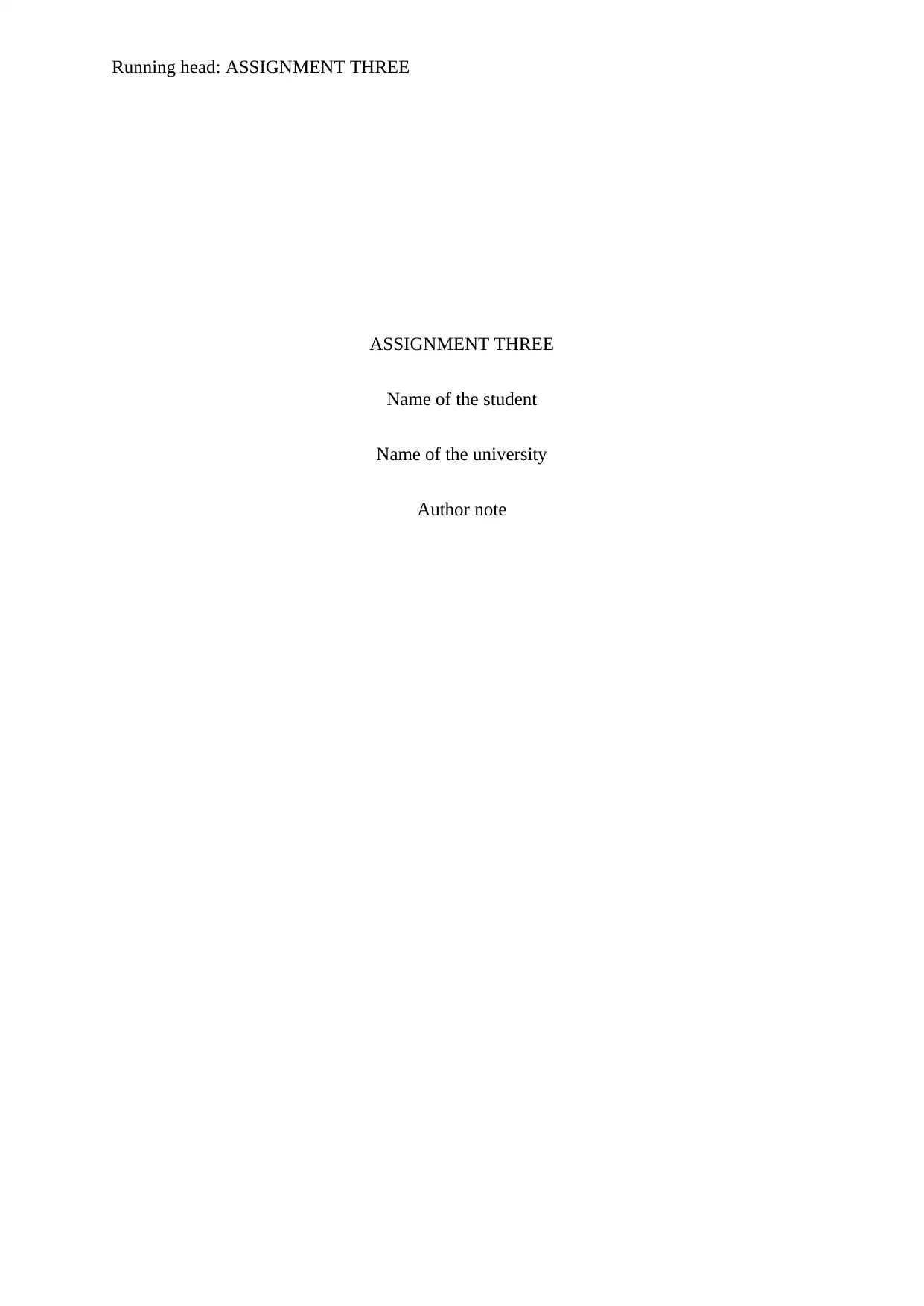
Running head: ASSIGNMENT THREE
ASSIGNMENT THREE
Name of the student
Name of the university
Author note
ASSIGNMENT THREE
Name of the student
Name of the university
Author note
Paraphrase This Document
Need a fresh take? Get an instant paraphrase of this document with our AI Paraphraser
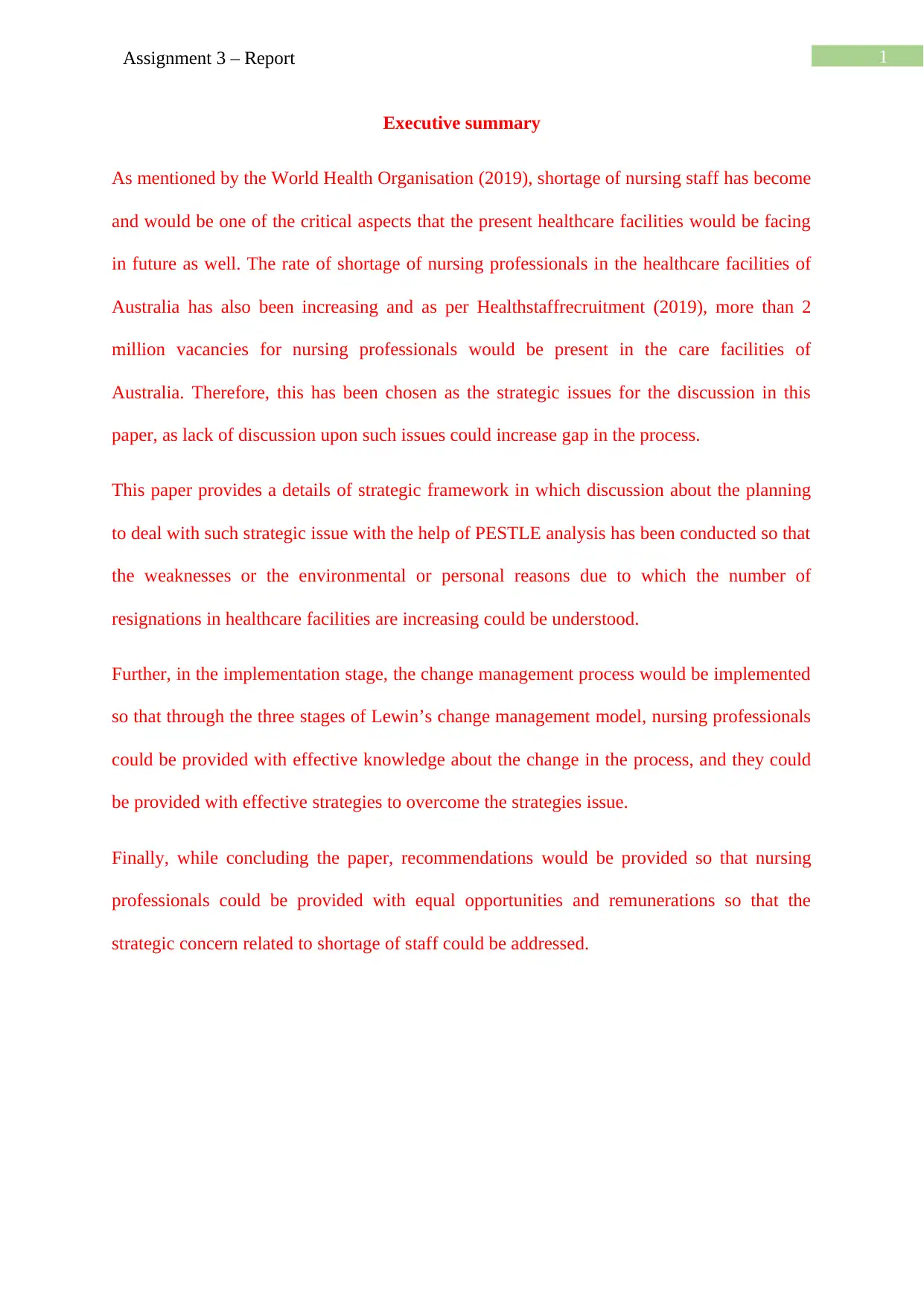
1Assignment 3 – Report
Executive summary
As mentioned by the World Health Organisation (2019), shortage of nursing staff has become
and would be one of the critical aspects that the present healthcare facilities would be facing
in future as well. The rate of shortage of nursing professionals in the healthcare facilities of
Australia has also been increasing and as per Healthstaffrecruitment (2019), more than 2
million vacancies for nursing professionals would be present in the care facilities of
Australia. Therefore, this has been chosen as the strategic issues for the discussion in this
paper, as lack of discussion upon such issues could increase gap in the process.
This paper provides a details of strategic framework in which discussion about the planning
to deal with such strategic issue with the help of PESTLE analysis has been conducted so that
the weaknesses or the environmental or personal reasons due to which the number of
resignations in healthcare facilities are increasing could be understood.
Further, in the implementation stage, the change management process would be implemented
so that through the three stages of Lewin’s change management model, nursing professionals
could be provided with effective knowledge about the change in the process, and they could
be provided with effective strategies to overcome the strategies issue.
Finally, while concluding the paper, recommendations would be provided so that nursing
professionals could be provided with equal opportunities and remunerations so that the
strategic concern related to shortage of staff could be addressed.
Executive summary
As mentioned by the World Health Organisation (2019), shortage of nursing staff has become
and would be one of the critical aspects that the present healthcare facilities would be facing
in future as well. The rate of shortage of nursing professionals in the healthcare facilities of
Australia has also been increasing and as per Healthstaffrecruitment (2019), more than 2
million vacancies for nursing professionals would be present in the care facilities of
Australia. Therefore, this has been chosen as the strategic issues for the discussion in this
paper, as lack of discussion upon such issues could increase gap in the process.
This paper provides a details of strategic framework in which discussion about the planning
to deal with such strategic issue with the help of PESTLE analysis has been conducted so that
the weaknesses or the environmental or personal reasons due to which the number of
resignations in healthcare facilities are increasing could be understood.
Further, in the implementation stage, the change management process would be implemented
so that through the three stages of Lewin’s change management model, nursing professionals
could be provided with effective knowledge about the change in the process, and they could
be provided with effective strategies to overcome the strategies issue.
Finally, while concluding the paper, recommendations would be provided so that nursing
professionals could be provided with equal opportunities and remunerations so that the
strategic concern related to shortage of staff could be addressed.
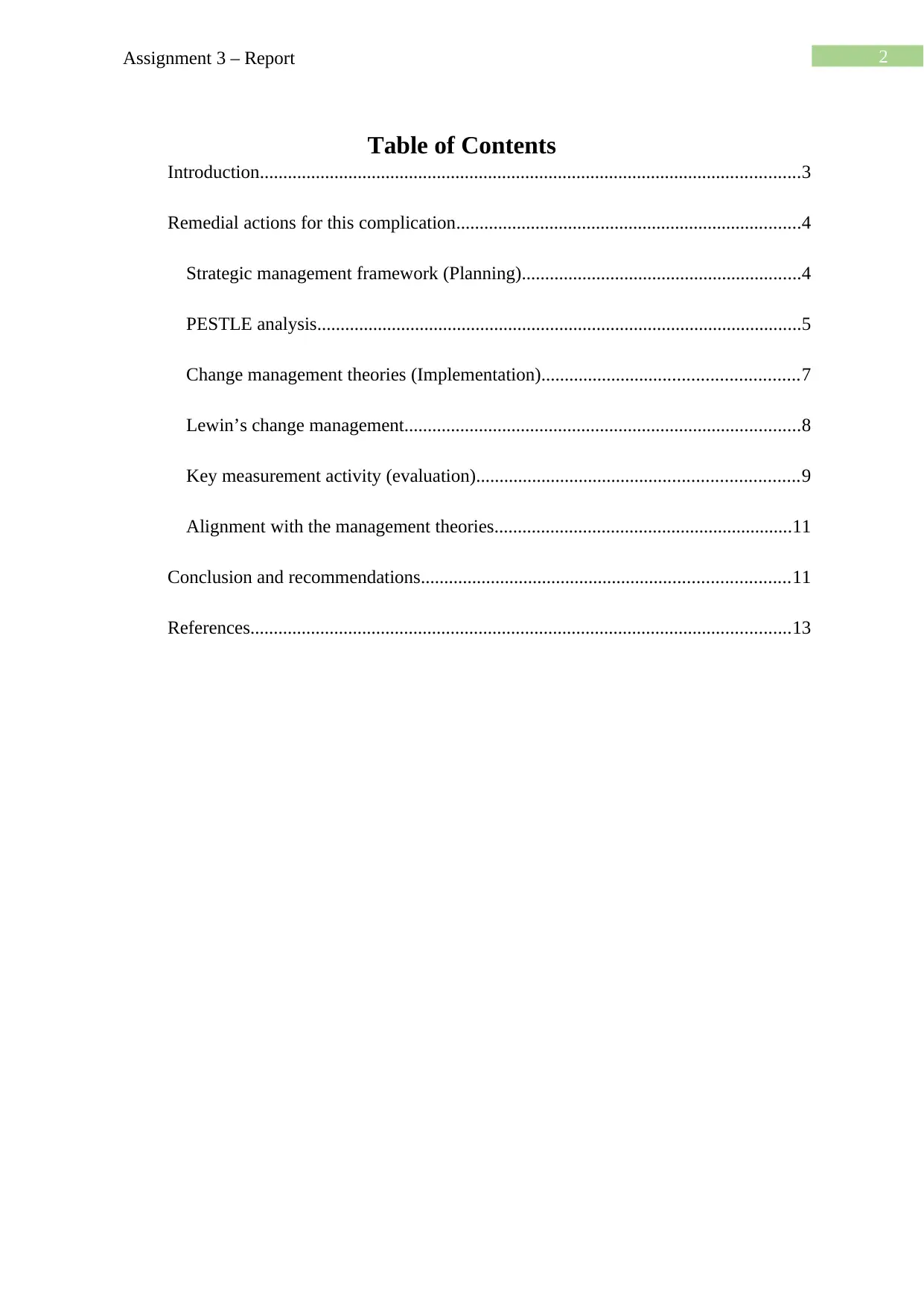
2Assignment 3 – Report
Table of Contents
Introduction....................................................................................................................3
Remedial actions for this complication..........................................................................4
Strategic management framework (Planning)............................................................4
PESTLE analysis........................................................................................................5
Change management theories (Implementation).......................................................7
Lewin’s change management.....................................................................................8
Key measurement activity (evaluation).....................................................................9
Alignment with the management theories................................................................11
Conclusion and recommendations...............................................................................11
References....................................................................................................................13
Table of Contents
Introduction....................................................................................................................3
Remedial actions for this complication..........................................................................4
Strategic management framework (Planning)............................................................4
PESTLE analysis........................................................................................................5
Change management theories (Implementation).......................................................7
Lewin’s change management.....................................................................................8
Key measurement activity (evaluation).....................................................................9
Alignment with the management theories................................................................11
Conclusion and recommendations...............................................................................11
References....................................................................................................................13
⊘ This is a preview!⊘
Do you want full access?
Subscribe today to unlock all pages.

Trusted by 1+ million students worldwide
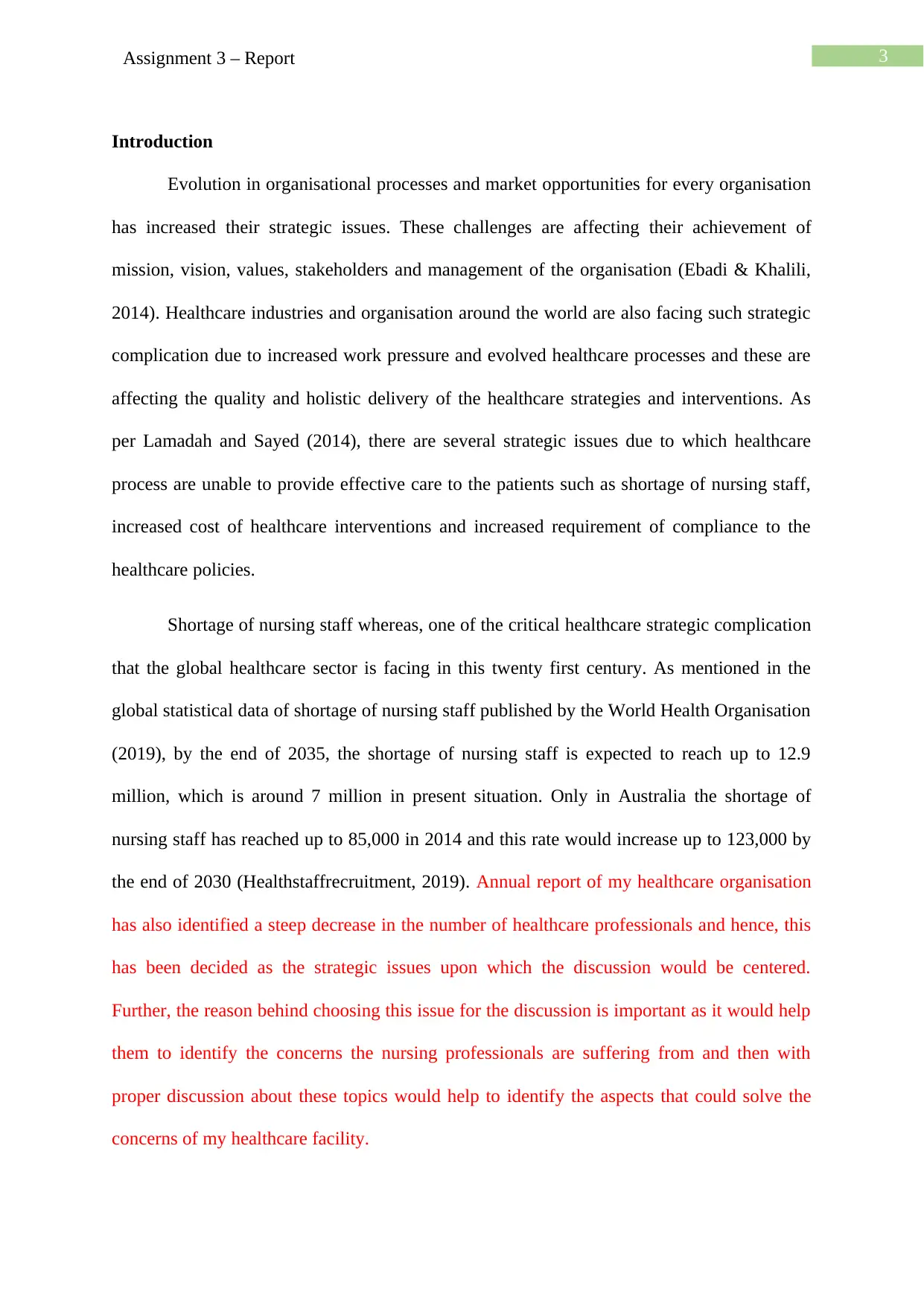
3Assignment 3 – Report
Introduction
Evolution in organisational processes and market opportunities for every organisation
has increased their strategic issues. These challenges are affecting their achievement of
mission, vision, values, stakeholders and management of the organisation (Ebadi & Khalili,
2014). Healthcare industries and organisation around the world are also facing such strategic
complication due to increased work pressure and evolved healthcare processes and these are
affecting the quality and holistic delivery of the healthcare strategies and interventions. As
per Lamadah and Sayed (2014), there are several strategic issues due to which healthcare
process are unable to provide effective care to the patients such as shortage of nursing staff,
increased cost of healthcare interventions and increased requirement of compliance to the
healthcare policies.
Shortage of nursing staff whereas, one of the critical healthcare strategic complication
that the global healthcare sector is facing in this twenty first century. As mentioned in the
global statistical data of shortage of nursing staff published by the World Health Organisation
(2019), by the end of 2035, the shortage of nursing staff is expected to reach up to 12.9
million, which is around 7 million in present situation. Only in Australia the shortage of
nursing staff has reached up to 85,000 in 2014 and this rate would increase up to 123,000 by
the end of 2030 (Healthstaffrecruitment, 2019). Annual report of my healthcare organisation
has also identified a steep decrease in the number of healthcare professionals and hence, this
has been decided as the strategic issues upon which the discussion would be centered.
Further, the reason behind choosing this issue for the discussion is important as it would help
them to identify the concerns the nursing professionals are suffering from and then with
proper discussion about these topics would help to identify the aspects that could solve the
concerns of my healthcare facility.
Introduction
Evolution in organisational processes and market opportunities for every organisation
has increased their strategic issues. These challenges are affecting their achievement of
mission, vision, values, stakeholders and management of the organisation (Ebadi & Khalili,
2014). Healthcare industries and organisation around the world are also facing such strategic
complication due to increased work pressure and evolved healthcare processes and these are
affecting the quality and holistic delivery of the healthcare strategies and interventions. As
per Lamadah and Sayed (2014), there are several strategic issues due to which healthcare
process are unable to provide effective care to the patients such as shortage of nursing staff,
increased cost of healthcare interventions and increased requirement of compliance to the
healthcare policies.
Shortage of nursing staff whereas, one of the critical healthcare strategic complication
that the global healthcare sector is facing in this twenty first century. As mentioned in the
global statistical data of shortage of nursing staff published by the World Health Organisation
(2019), by the end of 2035, the shortage of nursing staff is expected to reach up to 12.9
million, which is around 7 million in present situation. Only in Australia the shortage of
nursing staff has reached up to 85,000 in 2014 and this rate would increase up to 123,000 by
the end of 2030 (Healthstaffrecruitment, 2019). Annual report of my healthcare organisation
has also identified a steep decrease in the number of healthcare professionals and hence, this
has been decided as the strategic issues upon which the discussion would be centered.
Further, the reason behind choosing this issue for the discussion is important as it would help
them to identify the concerns the nursing professionals are suffering from and then with
proper discussion about these topics would help to identify the aspects that could solve the
concerns of my healthcare facility.
Paraphrase This Document
Need a fresh take? Get an instant paraphrase of this document with our AI Paraphraser
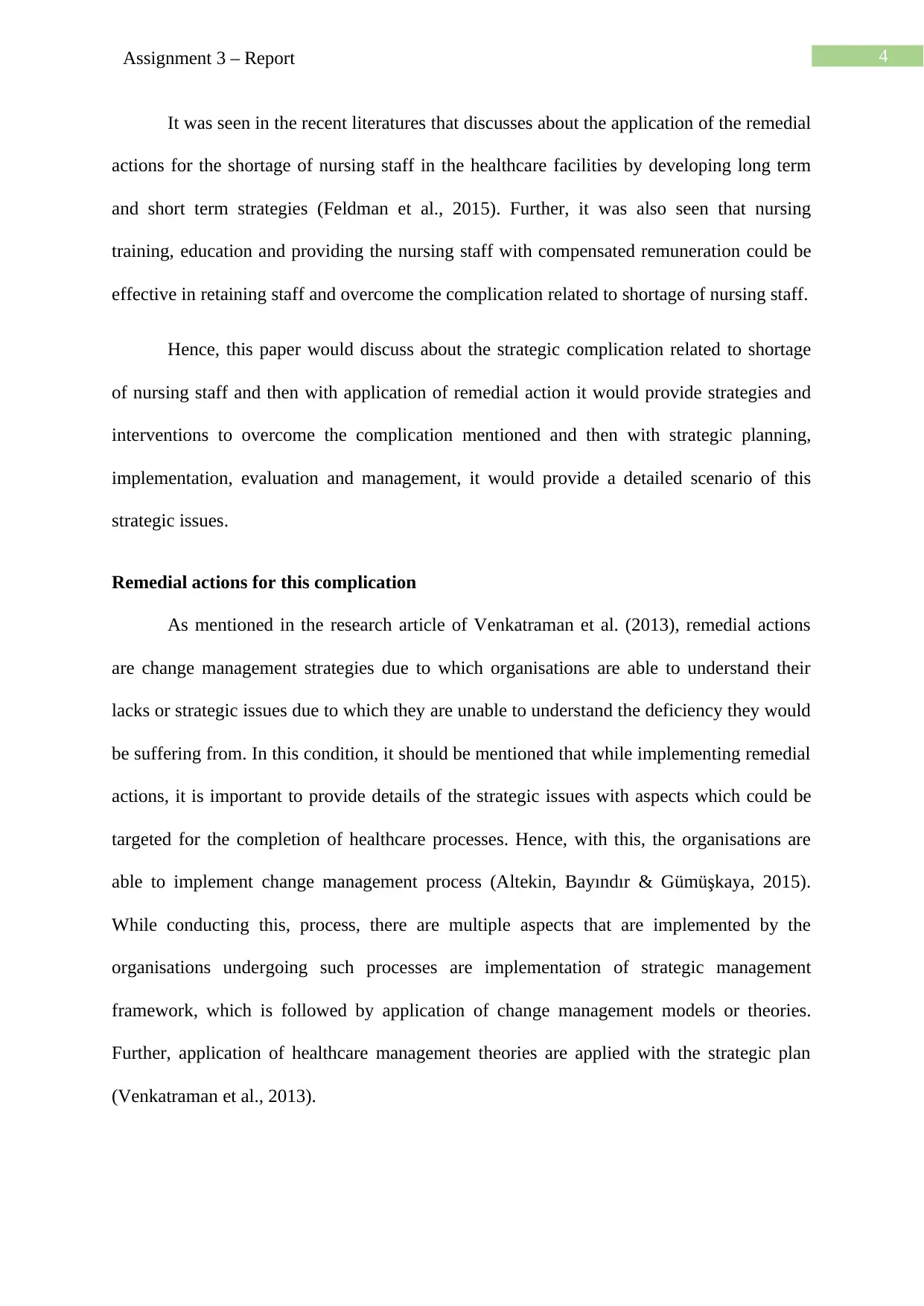
4Assignment 3 – Report
It was seen in the recent literatures that discusses about the application of the remedial
actions for the shortage of nursing staff in the healthcare facilities by developing long term
and short term strategies (Feldman et al., 2015). Further, it was also seen that nursing
training, education and providing the nursing staff with compensated remuneration could be
effective in retaining staff and overcome the complication related to shortage of nursing staff.
Hence, this paper would discuss about the strategic complication related to shortage
of nursing staff and then with application of remedial action it would provide strategies and
interventions to overcome the complication mentioned and then with strategic planning,
implementation, evaluation and management, it would provide a detailed scenario of this
strategic issues.
Remedial actions for this complication
As mentioned in the research article of Venkatraman et al. (2013), remedial actions
are change management strategies due to which organisations are able to understand their
lacks or strategic issues due to which they are unable to understand the deficiency they would
be suffering from. In this condition, it should be mentioned that while implementing remedial
actions, it is important to provide details of the strategic issues with aspects which could be
targeted for the completion of healthcare processes. Hence, with this, the organisations are
able to implement change management process (Altekin, Bayındır & Gümüşkaya, 2015).
While conducting this, process, there are multiple aspects that are implemented by the
organisations undergoing such processes are implementation of strategic management
framework, which is followed by application of change management models or theories.
Further, application of healthcare management theories are applied with the strategic plan
(Venkatraman et al., 2013).
It was seen in the recent literatures that discusses about the application of the remedial
actions for the shortage of nursing staff in the healthcare facilities by developing long term
and short term strategies (Feldman et al., 2015). Further, it was also seen that nursing
training, education and providing the nursing staff with compensated remuneration could be
effective in retaining staff and overcome the complication related to shortage of nursing staff.
Hence, this paper would discuss about the strategic complication related to shortage
of nursing staff and then with application of remedial action it would provide strategies and
interventions to overcome the complication mentioned and then with strategic planning,
implementation, evaluation and management, it would provide a detailed scenario of this
strategic issues.
Remedial actions for this complication
As mentioned in the research article of Venkatraman et al. (2013), remedial actions
are change management strategies due to which organisations are able to understand their
lacks or strategic issues due to which they are unable to understand the deficiency they would
be suffering from. In this condition, it should be mentioned that while implementing remedial
actions, it is important to provide details of the strategic issues with aspects which could be
targeted for the completion of healthcare processes. Hence, with this, the organisations are
able to implement change management process (Altekin, Bayındır & Gümüşkaya, 2015).
While conducting this, process, there are multiple aspects that are implemented by the
organisations undergoing such processes are implementation of strategic management
framework, which is followed by application of change management models or theories.
Further, application of healthcare management theories are applied with the strategic plan
(Venkatraman et al., 2013).
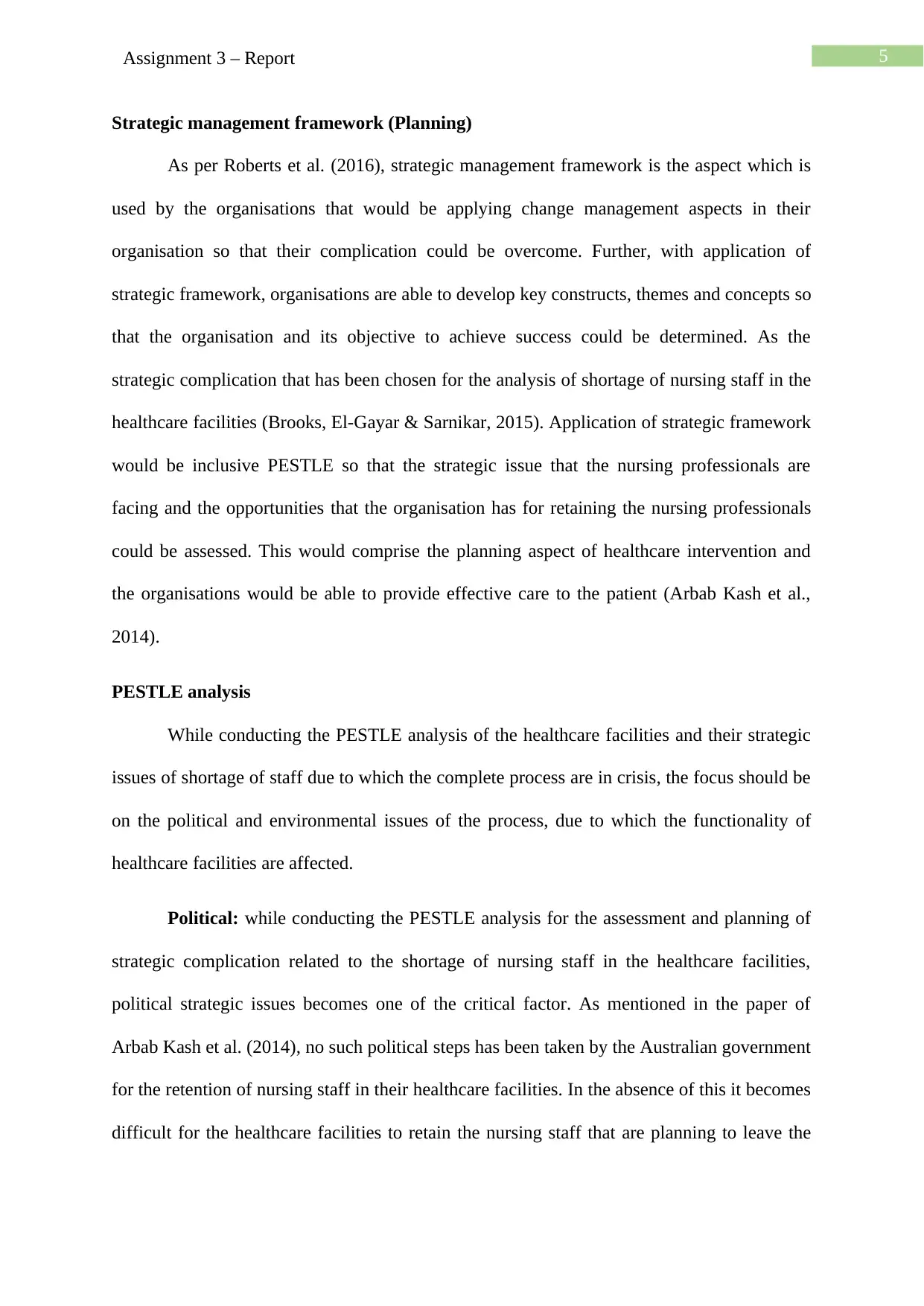
5Assignment 3 – Report
Strategic management framework (Planning)
As per Roberts et al. (2016), strategic management framework is the aspect which is
used by the organisations that would be applying change management aspects in their
organisation so that their complication could be overcome. Further, with application of
strategic framework, organisations are able to develop key constructs, themes and concepts so
that the organisation and its objective to achieve success could be determined. As the
strategic complication that has been chosen for the analysis of shortage of nursing staff in the
healthcare facilities (Brooks, El-Gayar & Sarnikar, 2015). Application of strategic framework
would be inclusive PESTLE so that the strategic issue that the nursing professionals are
facing and the opportunities that the organisation has for retaining the nursing professionals
could be assessed. This would comprise the planning aspect of healthcare intervention and
the organisations would be able to provide effective care to the patient (Arbab Kash et al.,
2014).
PESTLE analysis
While conducting the PESTLE analysis of the healthcare facilities and their strategic
issues of shortage of staff due to which the complete process are in crisis, the focus should be
on the political and environmental issues of the process, due to which the functionality of
healthcare facilities are affected.
Political: while conducting the PESTLE analysis for the assessment and planning of
strategic complication related to the shortage of nursing staff in the healthcare facilities,
political strategic issues becomes one of the critical factor. As mentioned in the paper of
Arbab Kash et al. (2014), no such political steps has been taken by the Australian government
for the retention of nursing staff in their healthcare facilities. In the absence of this it becomes
difficult for the healthcare facilities to retain the nursing staff that are planning to leave the
Strategic management framework (Planning)
As per Roberts et al. (2016), strategic management framework is the aspect which is
used by the organisations that would be applying change management aspects in their
organisation so that their complication could be overcome. Further, with application of
strategic framework, organisations are able to develop key constructs, themes and concepts so
that the organisation and its objective to achieve success could be determined. As the
strategic complication that has been chosen for the analysis of shortage of nursing staff in the
healthcare facilities (Brooks, El-Gayar & Sarnikar, 2015). Application of strategic framework
would be inclusive PESTLE so that the strategic issue that the nursing professionals are
facing and the opportunities that the organisation has for retaining the nursing professionals
could be assessed. This would comprise the planning aspect of healthcare intervention and
the organisations would be able to provide effective care to the patient (Arbab Kash et al.,
2014).
PESTLE analysis
While conducting the PESTLE analysis of the healthcare facilities and their strategic
issues of shortage of staff due to which the complete process are in crisis, the focus should be
on the political and environmental issues of the process, due to which the functionality of
healthcare facilities are affected.
Political: while conducting the PESTLE analysis for the assessment and planning of
strategic complication related to the shortage of nursing staff in the healthcare facilities,
political strategic issues becomes one of the critical factor. As mentioned in the paper of
Arbab Kash et al. (2014), no such political steps has been taken by the Australian government
for the retention of nursing staff in their healthcare facilities. In the absence of this it becomes
difficult for the healthcare facilities to retain the nursing staff that are planning to leave the
⊘ This is a preview!⊘
Do you want full access?
Subscribe today to unlock all pages.

Trusted by 1+ million students worldwide
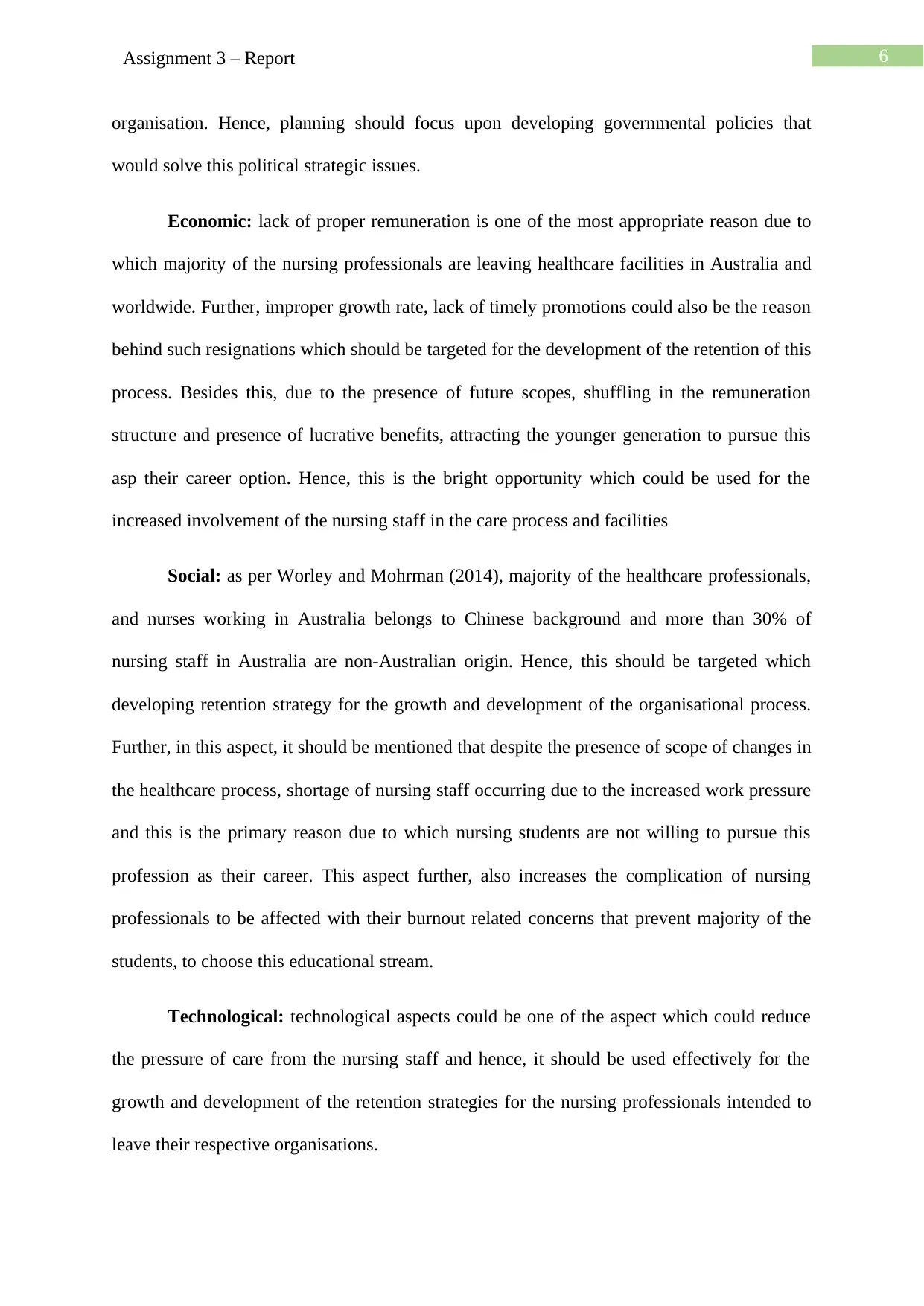
6Assignment 3 – Report
organisation. Hence, planning should focus upon developing governmental policies that
would solve this political strategic issues.
Economic: lack of proper remuneration is one of the most appropriate reason due to
which majority of the nursing professionals are leaving healthcare facilities in Australia and
worldwide. Further, improper growth rate, lack of timely promotions could also be the reason
behind such resignations which should be targeted for the development of the retention of this
process. Besides this, due to the presence of future scopes, shuffling in the remuneration
structure and presence of lucrative benefits, attracting the younger generation to pursue this
asp their career option. Hence, this is the bright opportunity which could be used for the
increased involvement of the nursing staff in the care process and facilities
Social: as per Worley and Mohrman (2014), majority of the healthcare professionals,
and nurses working in Australia belongs to Chinese background and more than 30% of
nursing staff in Australia are non-Australian origin. Hence, this should be targeted which
developing retention strategy for the growth and development of the organisational process.
Further, in this aspect, it should be mentioned that despite the presence of scope of changes in
the healthcare process, shortage of nursing staff occurring due to the increased work pressure
and this is the primary reason due to which nursing students are not willing to pursue this
profession as their career. This aspect further, also increases the complication of nursing
professionals to be affected with their burnout related concerns that prevent majority of the
students, to choose this educational stream.
Technological: technological aspects could be one of the aspect which could reduce
the pressure of care from the nursing staff and hence, it should be used effectively for the
growth and development of the retention strategies for the nursing professionals intended to
leave their respective organisations.
organisation. Hence, planning should focus upon developing governmental policies that
would solve this political strategic issues.
Economic: lack of proper remuneration is one of the most appropriate reason due to
which majority of the nursing professionals are leaving healthcare facilities in Australia and
worldwide. Further, improper growth rate, lack of timely promotions could also be the reason
behind such resignations which should be targeted for the development of the retention of this
process. Besides this, due to the presence of future scopes, shuffling in the remuneration
structure and presence of lucrative benefits, attracting the younger generation to pursue this
asp their career option. Hence, this is the bright opportunity which could be used for the
increased involvement of the nursing staff in the care process and facilities
Social: as per Worley and Mohrman (2014), majority of the healthcare professionals,
and nurses working in Australia belongs to Chinese background and more than 30% of
nursing staff in Australia are non-Australian origin. Hence, this should be targeted which
developing retention strategy for the growth and development of the organisational process.
Further, in this aspect, it should be mentioned that despite the presence of scope of changes in
the healthcare process, shortage of nursing staff occurring due to the increased work pressure
and this is the primary reason due to which nursing students are not willing to pursue this
profession as their career. This aspect further, also increases the complication of nursing
professionals to be affected with their burnout related concerns that prevent majority of the
students, to choose this educational stream.
Technological: technological aspects could be one of the aspect which could reduce
the pressure of care from the nursing staff and hence, it should be used effectively for the
growth and development of the retention strategies for the nursing professionals intended to
leave their respective organisations.
Paraphrase This Document
Need a fresh take? Get an instant paraphrase of this document with our AI Paraphraser
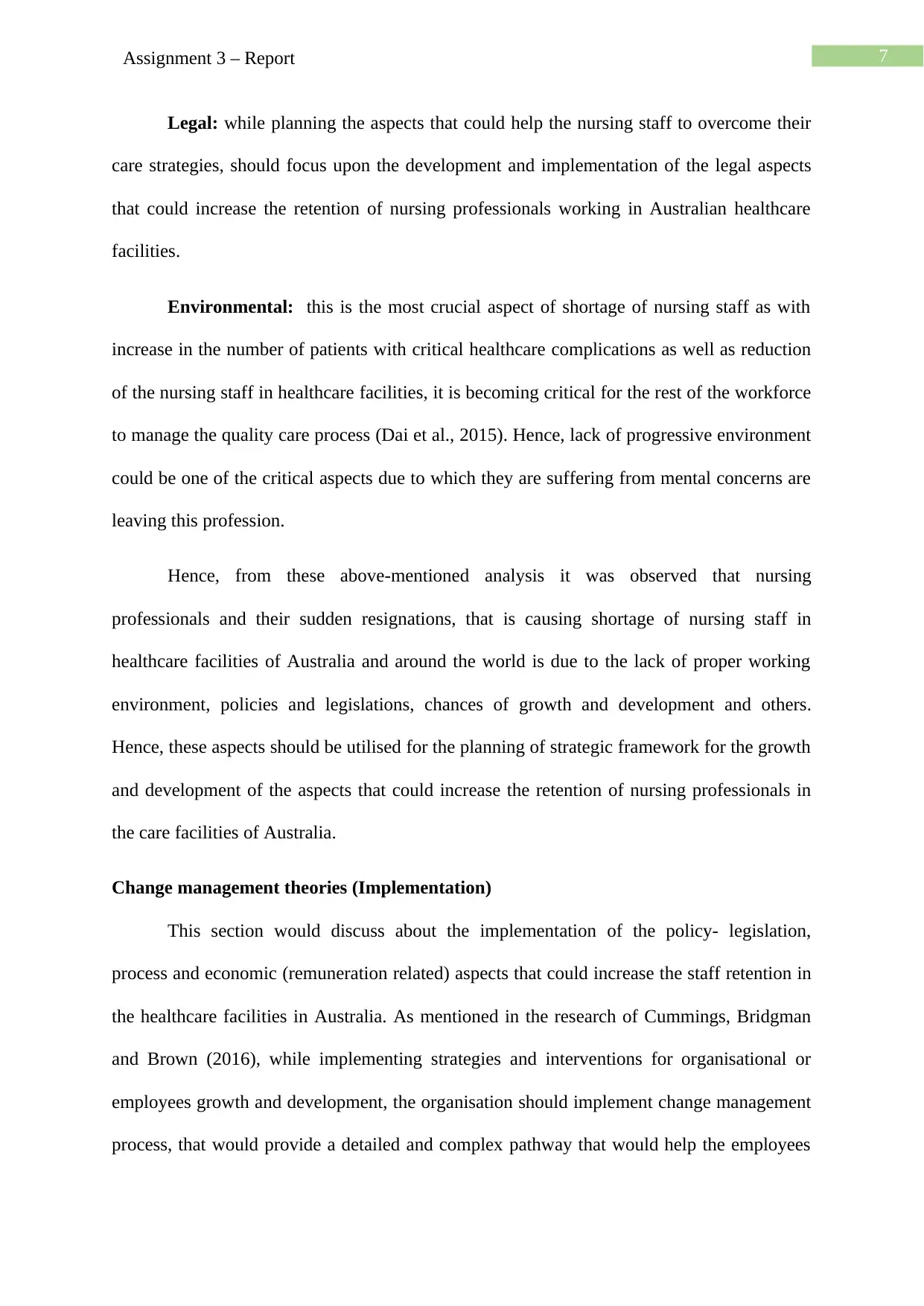
7Assignment 3 – Report
Legal: while planning the aspects that could help the nursing staff to overcome their
care strategies, should focus upon the development and implementation of the legal aspects
that could increase the retention of nursing professionals working in Australian healthcare
facilities.
Environmental: this is the most crucial aspect of shortage of nursing staff as with
increase in the number of patients with critical healthcare complications as well as reduction
of the nursing staff in healthcare facilities, it is becoming critical for the rest of the workforce
to manage the quality care process (Dai et al., 2015). Hence, lack of progressive environment
could be one of the critical aspects due to which they are suffering from mental concerns are
leaving this profession.
Hence, from these above-mentioned analysis it was observed that nursing
professionals and their sudden resignations, that is causing shortage of nursing staff in
healthcare facilities of Australia and around the world is due to the lack of proper working
environment, policies and legislations, chances of growth and development and others.
Hence, these aspects should be utilised for the planning of strategic framework for the growth
and development of the aspects that could increase the retention of nursing professionals in
the care facilities of Australia.
Change management theories (Implementation)
This section would discuss about the implementation of the policy- legislation,
process and economic (remuneration related) aspects that could increase the staff retention in
the healthcare facilities in Australia. As mentioned in the research of Cummings, Bridgman
and Brown (2016), while implementing strategies and interventions for organisational or
employees growth and development, the organisation should implement change management
process, that would provide a detailed and complex pathway that would help the employees
Legal: while planning the aspects that could help the nursing staff to overcome their
care strategies, should focus upon the development and implementation of the legal aspects
that could increase the retention of nursing professionals working in Australian healthcare
facilities.
Environmental: this is the most crucial aspect of shortage of nursing staff as with
increase in the number of patients with critical healthcare complications as well as reduction
of the nursing staff in healthcare facilities, it is becoming critical for the rest of the workforce
to manage the quality care process (Dai et al., 2015). Hence, lack of progressive environment
could be one of the critical aspects due to which they are suffering from mental concerns are
leaving this profession.
Hence, from these above-mentioned analysis it was observed that nursing
professionals and their sudden resignations, that is causing shortage of nursing staff in
healthcare facilities of Australia and around the world is due to the lack of proper working
environment, policies and legislations, chances of growth and development and others.
Hence, these aspects should be utilised for the planning of strategic framework for the growth
and development of the aspects that could increase the retention of nursing professionals in
the care facilities of Australia.
Change management theories (Implementation)
This section would discuss about the implementation of the policy- legislation,
process and economic (remuneration related) aspects that could increase the staff retention in
the healthcare facilities in Australia. As mentioned in the research of Cummings, Bridgman
and Brown (2016), while implementing strategies and interventions for organisational or
employees growth and development, the organisation should implement change management
process, that would provide a detailed and complex pathway that would help the employees
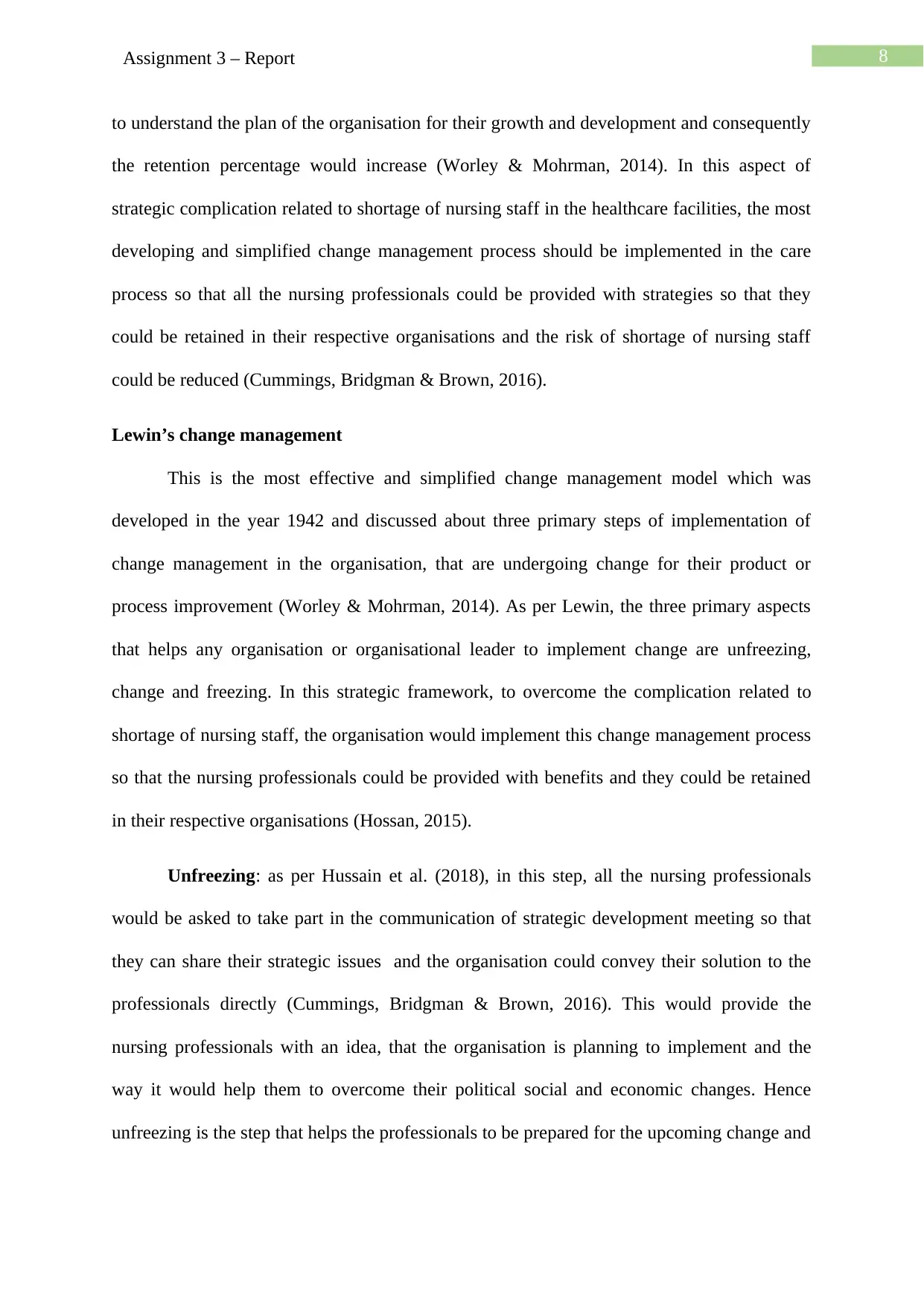
8Assignment 3 – Report
to understand the plan of the organisation for their growth and development and consequently
the retention percentage would increase (Worley & Mohrman, 2014). In this aspect of
strategic complication related to shortage of nursing staff in the healthcare facilities, the most
developing and simplified change management process should be implemented in the care
process so that all the nursing professionals could be provided with strategies so that they
could be retained in their respective organisations and the risk of shortage of nursing staff
could be reduced (Cummings, Bridgman & Brown, 2016).
Lewin’s change management
This is the most effective and simplified change management model which was
developed in the year 1942 and discussed about three primary steps of implementation of
change management in the organisation, that are undergoing change for their product or
process improvement (Worley & Mohrman, 2014). As per Lewin, the three primary aspects
that helps any organisation or organisational leader to implement change are unfreezing,
change and freezing. In this strategic framework, to overcome the complication related to
shortage of nursing staff, the organisation would implement this change management process
so that the nursing professionals could be provided with benefits and they could be retained
in their respective organisations (Hossan, 2015).
Unfreezing: as per Hussain et al. (2018), in this step, all the nursing professionals
would be asked to take part in the communication of strategic development meeting so that
they can share their strategic issues and the organisation could convey their solution to the
professionals directly (Cummings, Bridgman & Brown, 2016). This would provide the
nursing professionals with an idea, that the organisation is planning to implement and the
way it would help them to overcome their political social and economic changes. Hence
unfreezing is the step that helps the professionals to be prepared for the upcoming change and
to understand the plan of the organisation for their growth and development and consequently
the retention percentage would increase (Worley & Mohrman, 2014). In this aspect of
strategic complication related to shortage of nursing staff in the healthcare facilities, the most
developing and simplified change management process should be implemented in the care
process so that all the nursing professionals could be provided with strategies so that they
could be retained in their respective organisations and the risk of shortage of nursing staff
could be reduced (Cummings, Bridgman & Brown, 2016).
Lewin’s change management
This is the most effective and simplified change management model which was
developed in the year 1942 and discussed about three primary steps of implementation of
change management in the organisation, that are undergoing change for their product or
process improvement (Worley & Mohrman, 2014). As per Lewin, the three primary aspects
that helps any organisation or organisational leader to implement change are unfreezing,
change and freezing. In this strategic framework, to overcome the complication related to
shortage of nursing staff, the organisation would implement this change management process
so that the nursing professionals could be provided with benefits and they could be retained
in their respective organisations (Hossan, 2015).
Unfreezing: as per Hussain et al. (2018), in this step, all the nursing professionals
would be asked to take part in the communication of strategic development meeting so that
they can share their strategic issues and the organisation could convey their solution to the
professionals directly (Cummings, Bridgman & Brown, 2016). This would provide the
nursing professionals with an idea, that the organisation is planning to implement and the
way it would help them to overcome their political social and economic changes. Hence
unfreezing is the step that helps the professionals to be prepared for the upcoming change and
⊘ This is a preview!⊘
Do you want full access?
Subscribe today to unlock all pages.

Trusted by 1+ million students worldwide
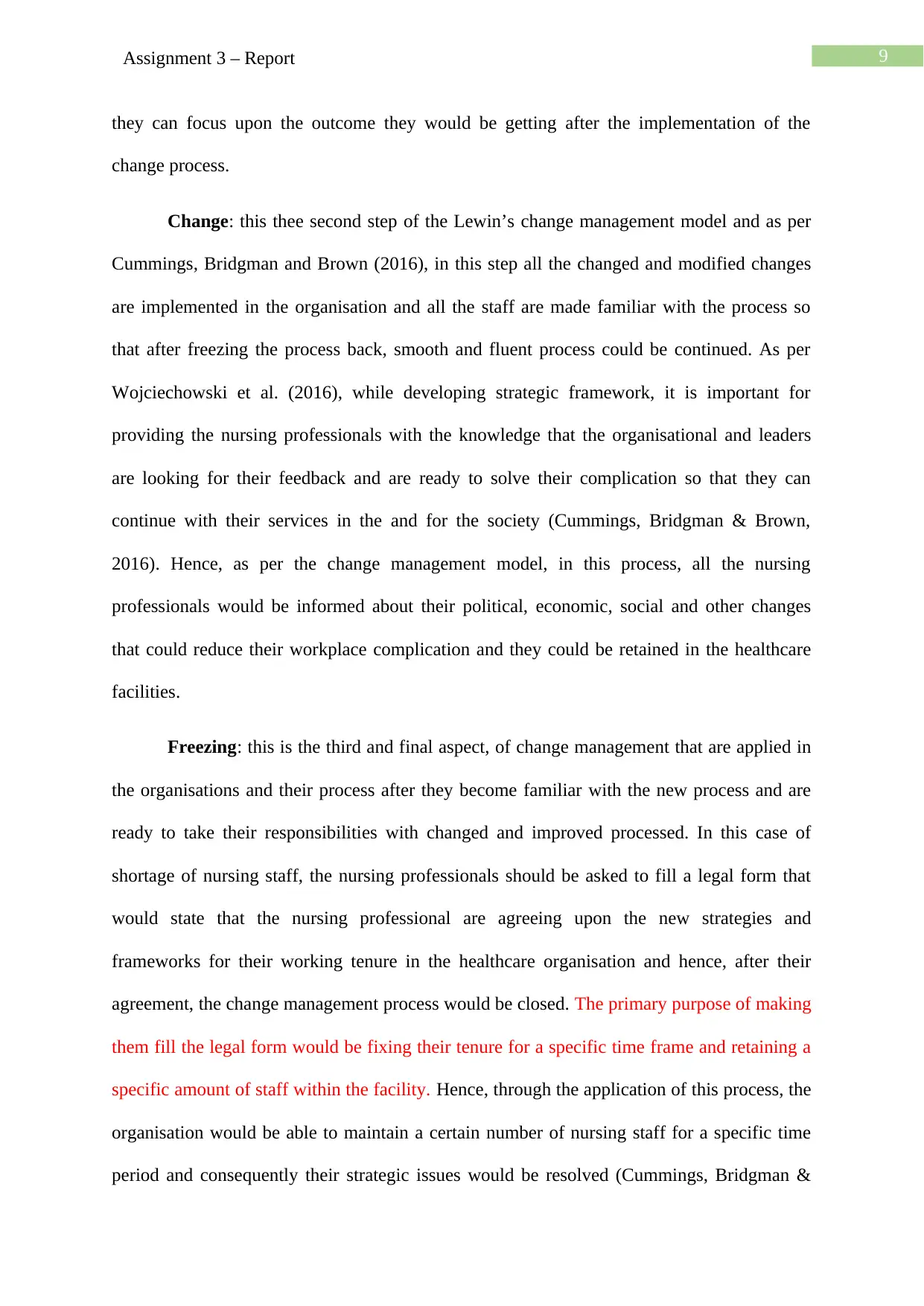
9Assignment 3 – Report
they can focus upon the outcome they would be getting after the implementation of the
change process.
Change: this thee second step of the Lewin’s change management model and as per
Cummings, Bridgman and Brown (2016), in this step all the changed and modified changes
are implemented in the organisation and all the staff are made familiar with the process so
that after freezing the process back, smooth and fluent process could be continued. As per
Wojciechowski et al. (2016), while developing strategic framework, it is important for
providing the nursing professionals with the knowledge that the organisational and leaders
are looking for their feedback and are ready to solve their complication so that they can
continue with their services in the and for the society (Cummings, Bridgman & Brown,
2016). Hence, as per the change management model, in this process, all the nursing
professionals would be informed about their political, economic, social and other changes
that could reduce their workplace complication and they could be retained in the healthcare
facilities.
Freezing: this is the third and final aspect, of change management that are applied in
the organisations and their process after they become familiar with the new process and are
ready to take their responsibilities with changed and improved processed. In this case of
shortage of nursing staff, the nursing professionals should be asked to fill a legal form that
would state that the nursing professional are agreeing upon the new strategies and
frameworks for their working tenure in the healthcare organisation and hence, after their
agreement, the change management process would be closed. The primary purpose of making
them fill the legal form would be fixing their tenure for a specific time frame and retaining a
specific amount of staff within the facility. Hence, through the application of this process, the
organisation would be able to maintain a certain number of nursing staff for a specific time
period and consequently their strategic issues would be resolved (Cummings, Bridgman &
they can focus upon the outcome they would be getting after the implementation of the
change process.
Change: this thee second step of the Lewin’s change management model and as per
Cummings, Bridgman and Brown (2016), in this step all the changed and modified changes
are implemented in the organisation and all the staff are made familiar with the process so
that after freezing the process back, smooth and fluent process could be continued. As per
Wojciechowski et al. (2016), while developing strategic framework, it is important for
providing the nursing professionals with the knowledge that the organisational and leaders
are looking for their feedback and are ready to solve their complication so that they can
continue with their services in the and for the society (Cummings, Bridgman & Brown,
2016). Hence, as per the change management model, in this process, all the nursing
professionals would be informed about their political, economic, social and other changes
that could reduce their workplace complication and they could be retained in the healthcare
facilities.
Freezing: this is the third and final aspect, of change management that are applied in
the organisations and their process after they become familiar with the new process and are
ready to take their responsibilities with changed and improved processed. In this case of
shortage of nursing staff, the nursing professionals should be asked to fill a legal form that
would state that the nursing professional are agreeing upon the new strategies and
frameworks for their working tenure in the healthcare organisation and hence, after their
agreement, the change management process would be closed. The primary purpose of making
them fill the legal form would be fixing their tenure for a specific time frame and retaining a
specific amount of staff within the facility. Hence, through the application of this process, the
organisation would be able to maintain a certain number of nursing staff for a specific time
period and consequently their strategic issues would be resolved (Cummings, Bridgman &
Paraphrase This Document
Need a fresh take? Get an instant paraphrase of this document with our AI Paraphraser
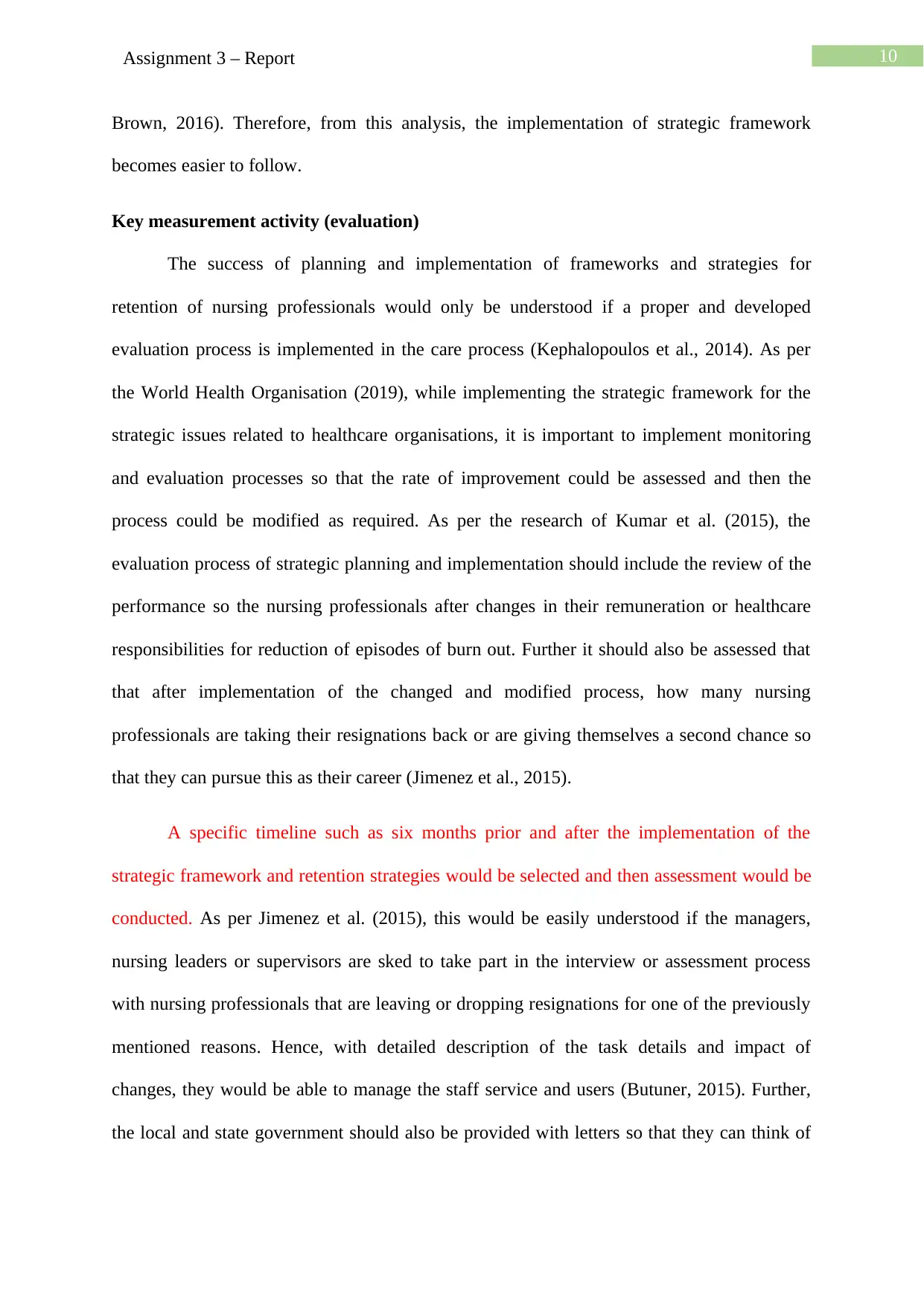
10Assignment 3 – Report
Brown, 2016). Therefore, from this analysis, the implementation of strategic framework
becomes easier to follow.
Key measurement activity (evaluation)
The success of planning and implementation of frameworks and strategies for
retention of nursing professionals would only be understood if a proper and developed
evaluation process is implemented in the care process (Kephalopoulos et al., 2014). As per
the World Health Organisation (2019), while implementing the strategic framework for the
strategic issues related to healthcare organisations, it is important to implement monitoring
and evaluation processes so that the rate of improvement could be assessed and then the
process could be modified as required. As per the research of Kumar et al. (2015), the
evaluation process of strategic planning and implementation should include the review of the
performance so the nursing professionals after changes in their remuneration or healthcare
responsibilities for reduction of episodes of burn out. Further it should also be assessed that
that after implementation of the changed and modified process, how many nursing
professionals are taking their resignations back or are giving themselves a second chance so
that they can pursue this as their career (Jimenez et al., 2015).
A specific timeline such as six months prior and after the implementation of the
strategic framework and retention strategies would be selected and then assessment would be
conducted. As per Jimenez et al. (2015), this would be easily understood if the managers,
nursing leaders or supervisors are sked to take part in the interview or assessment process
with nursing professionals that are leaving or dropping resignations for one of the previously
mentioned reasons. Hence, with detailed description of the task details and impact of
changes, they would be able to manage the staff service and users (Butuner, 2015). Further,
the local and state government should also be provided with letters so that they can think of
Brown, 2016). Therefore, from this analysis, the implementation of strategic framework
becomes easier to follow.
Key measurement activity (evaluation)
The success of planning and implementation of frameworks and strategies for
retention of nursing professionals would only be understood if a proper and developed
evaluation process is implemented in the care process (Kephalopoulos et al., 2014). As per
the World Health Organisation (2019), while implementing the strategic framework for the
strategic issues related to healthcare organisations, it is important to implement monitoring
and evaluation processes so that the rate of improvement could be assessed and then the
process could be modified as required. As per the research of Kumar et al. (2015), the
evaluation process of strategic planning and implementation should include the review of the
performance so the nursing professionals after changes in their remuneration or healthcare
responsibilities for reduction of episodes of burn out. Further it should also be assessed that
that after implementation of the changed and modified process, how many nursing
professionals are taking their resignations back or are giving themselves a second chance so
that they can pursue this as their career (Jimenez et al., 2015).
A specific timeline such as six months prior and after the implementation of the
strategic framework and retention strategies would be selected and then assessment would be
conducted. As per Jimenez et al. (2015), this would be easily understood if the managers,
nursing leaders or supervisors are sked to take part in the interview or assessment process
with nursing professionals that are leaving or dropping resignations for one of the previously
mentioned reasons. Hence, with detailed description of the task details and impact of
changes, they would be able to manage the staff service and users (Butuner, 2015). Further,
the local and state government should also be provided with letters so that they can think of
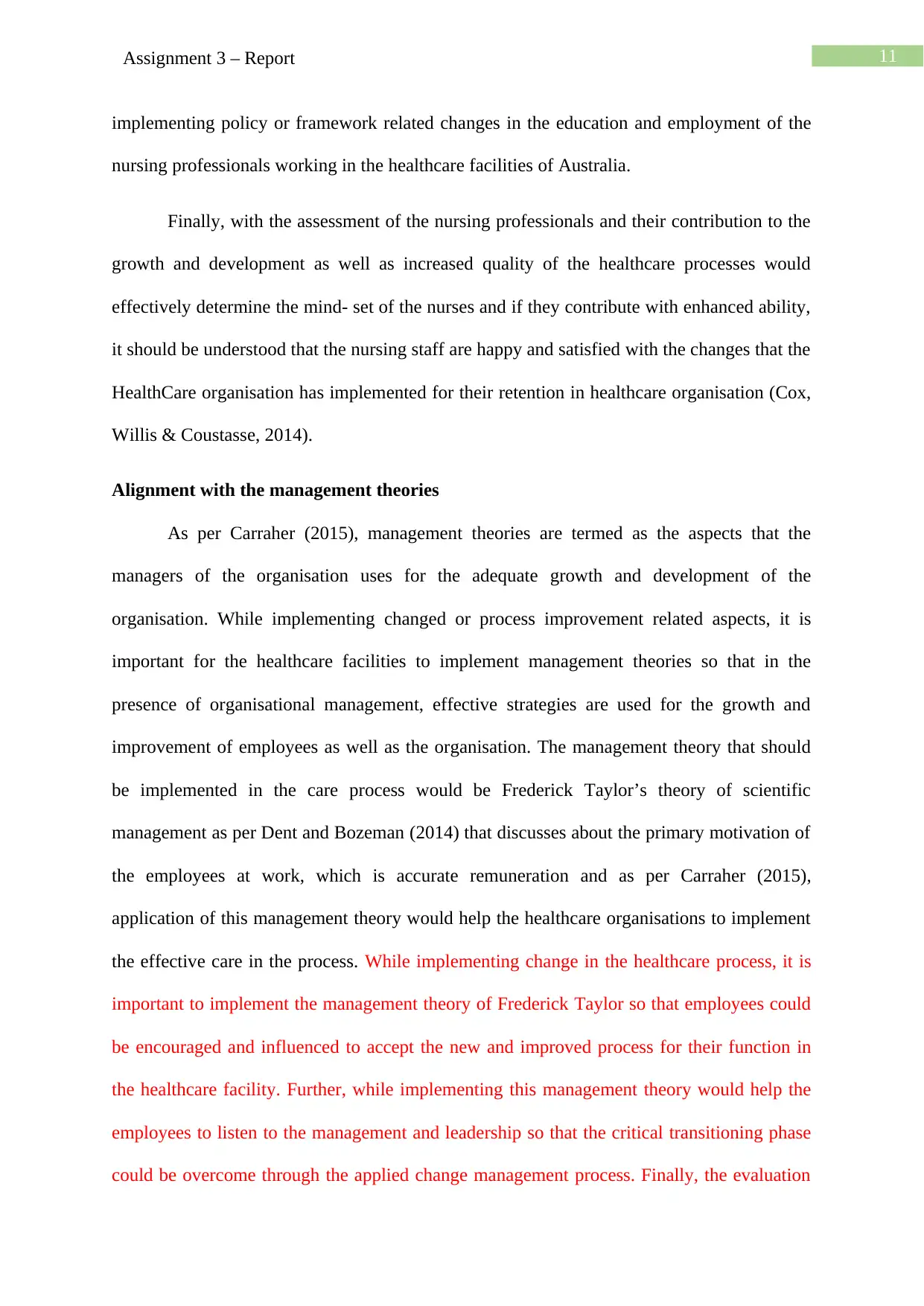
11Assignment 3 – Report
implementing policy or framework related changes in the education and employment of the
nursing professionals working in the healthcare facilities of Australia.
Finally, with the assessment of the nursing professionals and their contribution to the
growth and development as well as increased quality of the healthcare processes would
effectively determine the mind- set of the nurses and if they contribute with enhanced ability,
it should be understood that the nursing staff are happy and satisfied with the changes that the
HealthCare organisation has implemented for their retention in healthcare organisation (Cox,
Willis & Coustasse, 2014).
Alignment with the management theories
As per Carraher (2015), management theories are termed as the aspects that the
managers of the organisation uses for the adequate growth and development of the
organisation. While implementing changed or process improvement related aspects, it is
important for the healthcare facilities to implement management theories so that in the
presence of organisational management, effective strategies are used for the growth and
improvement of employees as well as the organisation. The management theory that should
be implemented in the care process would be Frederick Taylor’s theory of scientific
management as per Dent and Bozeman (2014) that discusses about the primary motivation of
the employees at work, which is accurate remuneration and as per Carraher (2015),
application of this management theory would help the healthcare organisations to implement
the effective care in the process. While implementing change in the healthcare process, it is
important to implement the management theory of Frederick Taylor so that employees could
be encouraged and influenced to accept the new and improved process for their function in
the healthcare facility. Further, while implementing this management theory would help the
employees to listen to the management and leadership so that the critical transitioning phase
could be overcome through the applied change management process. Finally, the evaluation
implementing policy or framework related changes in the education and employment of the
nursing professionals working in the healthcare facilities of Australia.
Finally, with the assessment of the nursing professionals and their contribution to the
growth and development as well as increased quality of the healthcare processes would
effectively determine the mind- set of the nurses and if they contribute with enhanced ability,
it should be understood that the nursing staff are happy and satisfied with the changes that the
HealthCare organisation has implemented for their retention in healthcare organisation (Cox,
Willis & Coustasse, 2014).
Alignment with the management theories
As per Carraher (2015), management theories are termed as the aspects that the
managers of the organisation uses for the adequate growth and development of the
organisation. While implementing changed or process improvement related aspects, it is
important for the healthcare facilities to implement management theories so that in the
presence of organisational management, effective strategies are used for the growth and
improvement of employees as well as the organisation. The management theory that should
be implemented in the care process would be Frederick Taylor’s theory of scientific
management as per Dent and Bozeman (2014) that discusses about the primary motivation of
the employees at work, which is accurate remuneration and as per Carraher (2015),
application of this management theory would help the healthcare organisations to implement
the effective care in the process. While implementing change in the healthcare process, it is
important to implement the management theory of Frederick Taylor so that employees could
be encouraged and influenced to accept the new and improved process for their function in
the healthcare facility. Further, while implementing this management theory would help the
employees to listen to the management and leadership so that the critical transitioning phase
could be overcome through the applied change management process. Finally, the evaluation
⊘ This is a preview!⊘
Do you want full access?
Subscribe today to unlock all pages.

Trusted by 1+ million students worldwide
1 out of 17
Related Documents
Your All-in-One AI-Powered Toolkit for Academic Success.
+13062052269
info@desklib.com
Available 24*7 on WhatsApp / Email
![[object Object]](/_next/static/media/star-bottom.7253800d.svg)
Unlock your academic potential
Copyright © 2020–2025 A2Z Services. All Rights Reserved. Developed and managed by ZUCOL.



